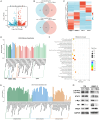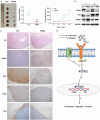ITM2A inhibits the progression of bladder cancer by downregulating the phosphorylation of STAT3
- PMID: 38859860
- PMCID: PMC11162684
- DOI: 10.62347/KHCC9690
ITM2A inhibits the progression of bladder cancer by downregulating the phosphorylation of STAT3
Abstract
Bladder cancer stands as one of the prevalent malignancies in urological clinics, highlighting the pressing need to uncover prognostic or therapeutic avenues. ITM2A, a transmembrane protein, has been identified as a suppressor in tumor progression recently. Our study underscored a significant correlation between low ITM2A expression in bladder cancer tissues and high tumor grade, AJCC stage, and poor overall survival time. Additionally, our findings demonstrated that reinstating ITM2A expression impeded cell proliferation, migration, and invasion, while conversely, its suppression enhanced these malignant behaviors. Furthermore, we elucidated that ITM2A could suppress malignant phenotypes of bladder cancer cells via inhibiting activation of the STAT3 induced by IL-6. In conclusion, our research unveiled the mechanistic role of ITM2A in inhibiting tumor progression, shedding light on its potential as a prognostic predictor and therapeutic target in bladder cancer management.
Keywords: ITM2A; bladder cancer; cell progression; phosphorylation of STAT3; tumor suppressor.
AJCR Copyright © 2024.
Conflict of interest statement
None.
Figures






Similar articles
-
Loss of ITM2A, a novel tumor suppressor of ovarian cancer through G2/M cell cycle arrest, is a poor prognostic factor of epithelial ovarian cancer.Gynecol Oncol. 2016 Mar;140(3):545-53. doi: 10.1016/j.ygyno.2015.12.006. Epub 2015 Dec 12. Gynecol Oncol. 2016. PMID: 26691219
-
Integral membrane protein 2A inhibits cell growth in human breast cancer via enhancing autophagy induction.Cell Commun Signal. 2019 Aug 22;17(1):105. doi: 10.1186/s12964-019-0422-7. Cell Commun Signal. 2019. PMID: 31438969 Free PMC article.
-
ITM2A as a Tumor Suppressor and Its Correlation With PD-L1 in Breast Cancer.Front Oncol. 2021 Feb 12;10:581733. doi: 10.3389/fonc.2020.581733. eCollection 2020. Front Oncol. 2021. PMID: 33680917 Free PMC article.
-
Prognostic and clinicopathological values of tissue expression of MFAP5 and ITM2A in triple-negative breast cancer: an immunohistochemical study.Contemp Oncol (Pozn). 2020;24(2):87-95. doi: 10.5114/wo.2020.97520. Epub 2020 Jul 3. Contemp Oncol (Pozn). 2020. PMID: 32774133 Free PMC article.
-
Crosstalk of miRNAs with signaling networks in bladder cancer progression: Therapeutic, diagnostic and prognostic functions.Pharmacol Res. 2022 Nov;185:106475. doi: 10.1016/j.phrs.2022.106475. Epub 2022 Oct 3. Pharmacol Res. 2022. PMID: 36202185 Review.
Cited by
-
ITM2A as a potential prognostic marker for triple-negative breast cancer.J Cancer. 2025 Jun 23;16(9):2903-2916. doi: 10.7150/jca.114801. eCollection 2025. J Cancer. 2025. PMID: 40657365 Free PMC article.
-
Integrating machine learning, bioinformatics and experimental verification to identify a novel prognostic marker associated with tumor immune microenvironment in head and neck squamous carcinoma.Front Immunol. 2024 Dec 10;15:1501486. doi: 10.3389/fimmu.2024.1501486. eCollection 2024. Front Immunol. 2024. PMID: 39720726 Free PMC article.
References
-
- Sung H, Ferlay J, Siegel RL, Laversanne M, Soerjomataram I, Jemal A, Bray F. Global cancer statistics 2020: GLOBOCAN estimates of incidence and mortality worldwide for 36 cancers in 185 countries. CA Cancer J Clin. 2021;71:209–249. - PubMed
-
- Valenza C, Antonarelli G, Giugliano F, Aurilio G, Verri E, Briganti A, Curigliano G, Necchi A. Emerging treatment landscape of non-muscle invasive bladder cancer. Expert Opin Biol Ther. 2022;22:717–734. - PubMed
-
- Li YJ, Zhang C, Martincuks A, Herrmann A, Yu H. STAT proteins in cancer: orchestration of metabolism. Nat Rev Cancer. 2023;23:115–134. - PubMed
LinkOut - more resources
Full Text Sources
Miscellaneous
